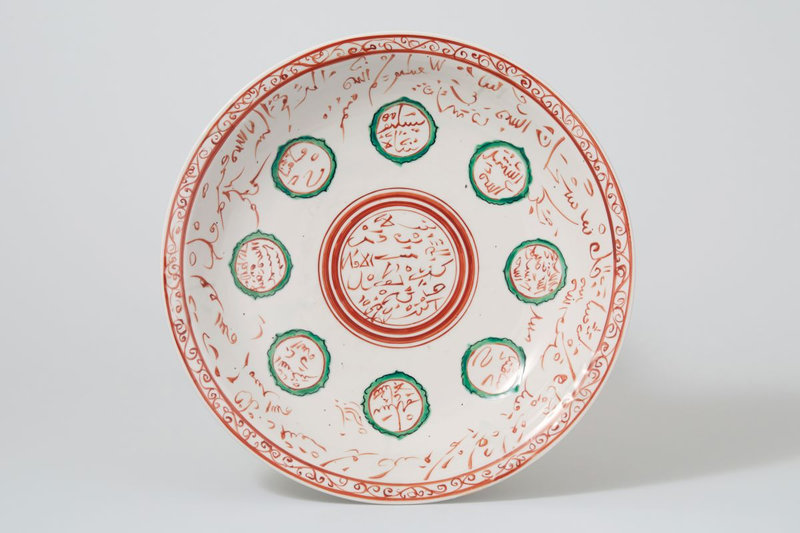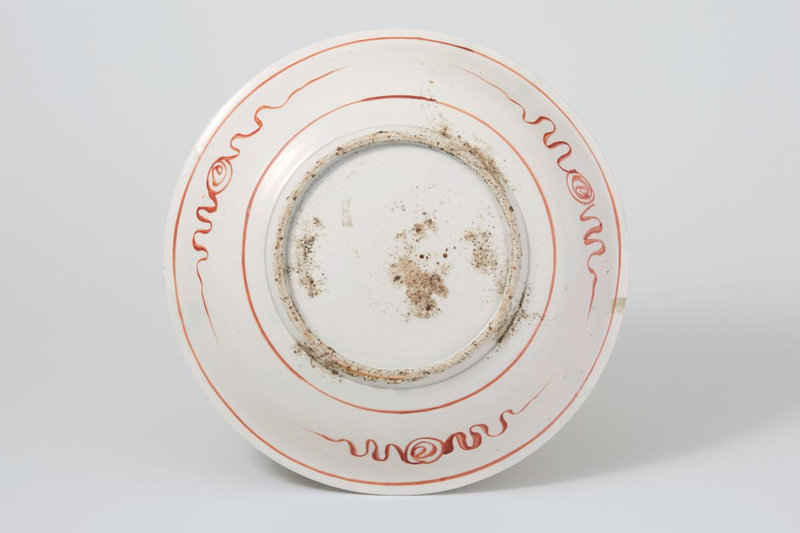Wucai 'Swatow-Type' dish with Arabic inscription design, Zhangzhou ware Ming dynasty, 17th century
Wucai 'Swatow-Type' dish with Arabic inscription design, Zhangzhou ware Ming dynasty, 17th century. 7.9 cm Diam. 39.5 cm. © Copyright 2023 MAYUYAMA & CO., LTD
Note: This is a large Gosu red painting board with a diameter of nearly 40 centimeters, made in the Zhangzhou kiln in Fujian during the Ming Dynasty.
The smooth white porcelain has a warm white color that complements the transparent bright colors of red and green. Nine large and small circles are drawn on the opening, and Arabic characters are lightly written throughout the space between the inside and the rim of the mouth. If you look at the back side, you can see that the simple lines drawn freely and freely are evenly distributed, and the plate does not have the scorch that can be seen here and there on Zhangzhou kiln discs, and only a small amount of unique sand sticks to it. yeah. Zhangzhou kiln pottery has a strong impression of being crude, but this work is a masterpiece with a white and smooth base, coloring of the paint, charring on the bottom and slight sand sticking.
The Arabic characters written in this passage are passages that praise Allah in Chapter 112 of the Quran, and it is said that Muslims living in what is now Southeast Asia, then called Nanhai, loved to recite these passages around the 17th century. Several Gosude daibans of the same hand have been confirmed, including those in the Jakarta National Museum, and the same scriptures are also inscribed on them.
Since the early Ming dynasty, the Zhangzhou kiln was a private kiln that produced a large amount of Gosude wares, not only red paintings, for the purpose of export, and exported not only to Japan and Southeast Asia, but also to Europe and Egypt. It was also introduced to Japan in the Edo period, where tea ceremony masters loved Akadama incense and Tamatori lion bowls. And this work is thought to have been made for countries in Southeast Asia, where there are many Muslims, including Indonesia. It can be seen that the Zhangzhou kiln at that time was made according to the tastes and needs of the recipients of export destinations.

/https%3A%2F%2Fprofilepics.canalblog.com%2Fprofilepics%2F1%2F0%2F100183.jpg)
/https%3A%2F%2Fstorage.canalblog.com%2F03%2F02%2F119589%2F96711876_o.jpg)
/https%3A%2F%2Fstorage.canalblog.com%2F11%2F31%2F119589%2F94773502_o.jpg)
/https%3A%2F%2Fstorage.canalblog.com%2F20%2F83%2F119589%2F94772815_o.jpg)
/https%3A%2F%2Fstorage.canalblog.com%2F26%2F72%2F119589%2F75604929_o.jpg)
/https%3A%2F%2Fstorage.canalblog.com%2F59%2F60%2F119589%2F26458628_o.jpg)




/image%2F1371349%2F20240512%2Fob_a8e9f9_telechargement.jpg)
/image%2F1371349%2F20240510%2Fob_0b2f11_441136990-1667014630735216-49602073491.jpg)
/image%2F1371349%2F20240506%2Fob_aa3a2b_441880613-1664589527644393-19430235809.jpg)
/image%2F1371349%2F20240325%2Fob_f3f664_telechargement-7.jpg)